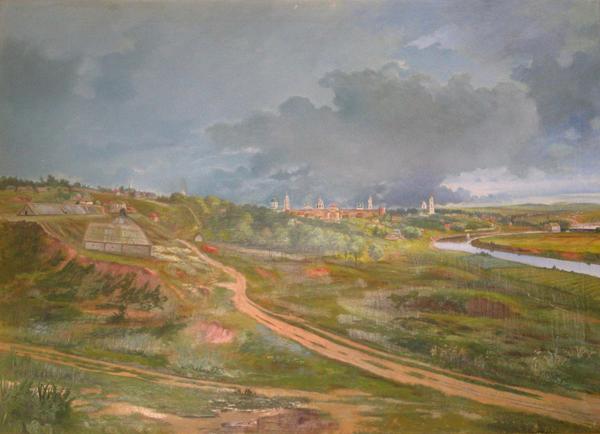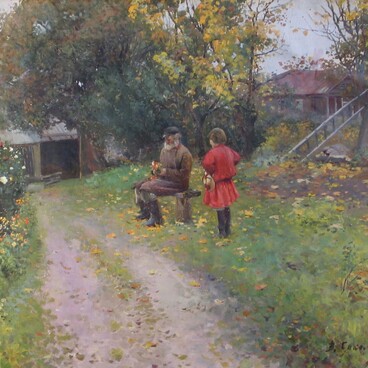Alexander Rodionovich Artemiev (1842–1914) was born in the Zaraysk village of Stolpovo in a peasant family. He is also known in the theatre society under the name Artem. It was under this name that he appeared in the productions of the newly founded Maly Art Theater. Anton Pavlovich Chekhov wrote roles in his plays especially for him. He played the roles of Firs (‘The Cherry Orchard’), Shamraev (‘The Seagull’), Waffles (‘Uncle Vanya’), Chebutykin (‘Three Sisters’). Among the best roles of Artyom are Perchikhin (‘The Philistines’ by Gorky) and Kuzovkin (‘Fortune’s Fool’ by Turgenev).
Theater was Artyom’s passion, but he could afford to participate in plays only at the end of his life, already being an elderly man. Up to this point, Alexander Artemyev made a living by teaching drawing and spelling. He graduated from the Moscow School of Painting, Sculpture and Architecture in 1878, after which he worked as a day-laborer artist and taught for 25 years.
Zaraysk Kremlin, visible in the distance, is the semantic center of the composition in Artemyev’s landscape. In 1521 Zaraysk was one of the cities of the Great Abatis Border, designed to protect Moscow from numerous raids of the Tatars. To strengthen the defensive function of the city, by order of the Grand Duke of Moscow Vasily III in 1528-1531, a stone Kremlin was erected on the banks of the Osyotr River. It was built according to the Italian canons of castle architecture and adapted for circular combat with the use of artillery. In the middle of the 17th century, the city lost its strategic importance and turned into a trade center; the Astrakhan tract passed through it, connecting Moscow with the Lower Volga region. From the middle of the 19th century, the city lost this function: in 1847 a new Ryazan highway was laid, and in 1865, traffic on the Moscow-Ryazan railway was opened. Both roads bypassed Zaraysk.
After these events, the city life slowed down, but it was this twist of history that allowed Zaraysk to preserve its identity.
Thanks to the painting by Artemyev, the viewer can form his own impression of Zaraysk in 1891. A small town on the banks of the river, to which country roads lead; houses on the way; the breadth and wealth of Russian nature. The artist depicted his native land with special warmth and trepidation.
The panorama painted by Alexander Artemyev at the end of the 19th century is still recognizable to contemporaries. The Zaraysk Kremlin is the only fully preserved Kremlin in the Moscow region; it is an object of cultural heritage of federal significance. Of course, time has made its own changes. Today, the architectural ensemble of the city is decorated with fewer temples than at the end of the 19th century.
Theater was Artyom’s passion, but he could afford to participate in plays only at the end of his life, already being an elderly man. Up to this point, Alexander Artemyev made a living by teaching drawing and spelling. He graduated from the Moscow School of Painting, Sculpture and Architecture in 1878, after which he worked as a day-laborer artist and taught for 25 years.
Zaraysk Kremlin, visible in the distance, is the semantic center of the composition in Artemyev’s landscape. In 1521 Zaraysk was one of the cities of the Great Abatis Border, designed to protect Moscow from numerous raids of the Tatars. To strengthen the defensive function of the city, by order of the Grand Duke of Moscow Vasily III in 1528-1531, a stone Kremlin was erected on the banks of the Osyotr River. It was built according to the Italian canons of castle architecture and adapted for circular combat with the use of artillery. In the middle of the 17th century, the city lost its strategic importance and turned into a trade center; the Astrakhan tract passed through it, connecting Moscow with the Lower Volga region. From the middle of the 19th century, the city lost this function: in 1847 a new Ryazan highway was laid, and in 1865, traffic on the Moscow-Ryazan railway was opened. Both roads bypassed Zaraysk.
After these events, the city life slowed down, but it was this twist of history that allowed Zaraysk to preserve its identity.
Thanks to the painting by Artemyev, the viewer can form his own impression of Zaraysk in 1891. A small town on the banks of the river, to which country roads lead; houses on the way; the breadth and wealth of Russian nature. The artist depicted his native land with special warmth and trepidation.
The panorama painted by Alexander Artemyev at the end of the 19th century is still recognizable to contemporaries. The Zaraysk Kremlin is the only fully preserved Kremlin in the Moscow region; it is an object of cultural heritage of federal significance. Of course, time has made its own changes. Today, the architectural ensemble of the city is decorated with fewer temples than at the end of the 19th century.



